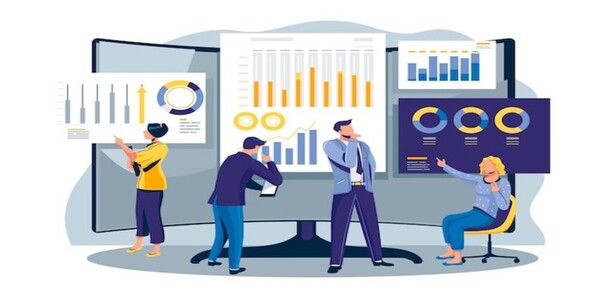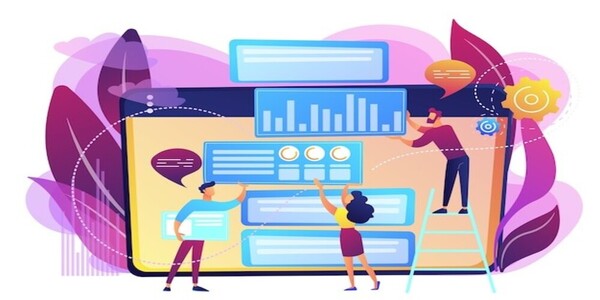
In the modern-day business environment, data is everywhere–from customer preferences and interactions to stock market trends and financial analysis. That’s why artificial intelligence (AI) and data science have become two of the most important tools for businesses looking to gain a comprehensive understanding of their operations. By utilizing AI and data science together, businesses can access powerful analytics that will unlock actionable insights into their environments so they can make more informed decisions about growth strategies or resource allocations. In this blog post, we’ll take an in-depth look at how leveraging these cutting-edge technologies can benefit organizations in fields such as finance, marketing, healthcare, retail manufacturing, and more.
Introducing AI and Data Science – What are they and what do they do together

Artificial Intelligence (AI) and Data Science are two closely related fields that work together to extract valuable insights and patterns from large and complex datasets.
AI is a branch of computer science that focuses on creating intelligent machines that can mimic human intelligence and perform tasks such as speech recognition, natural language processing, image recognition, and decision making. AI algorithms can learn from data and improve their performance over time, without explicit programming.
Data Science, on the other hand, is a multidisciplinary field that involves the use of statistical and computational methods to extract insights from data. Data scientists collect, process, and analyze large and complex datasets to uncover patterns, trends, and relationships that can be used to inform business decisions.
Together, AI and Data Science form a powerful combination that can help organizations unlock valuable insights from their data. AI can be used to create predictive models that can forecast future trends and identify potential risks or opportunities, while Data Science can be used to extract insights from these models and turn them into actionable business insights. For example, AI-powered chatbots can be used to automatically engage with customers and collect data on their preferences and behaviors. This data can then be analyzed by Data Scientists to gain insights into customer behavior, which can inform marketing and product development strategies.
In summary, AI and Data Science work together to help organizations extract valuable insights from their data, and use those insights to drive business growth and success.
Benefits of Combining Artificial Intelligence and Data Science

The combination of Artificial Intelligence (AI) and Data Science offers a wide range of benefits for organizations looking to leverage their data to drive business growth and success. Here are some of the key benefits of combining AI and Data Science:
- Improved Decision-Making: By analyzing vast amounts of data, AI-powered predictive models can help decision-makers to make better-informed decisions. These models can be used to identify trends, patterns, and anomalies in data, which can then be used to guide decision-making in areas such as sales, marketing, finance, and operations.
- Enhanced Customer Experience: AI-powered chatbots and virtual assistants can be used to engage with customers and collect data on their preferences and behaviors. Data Scientists can then analyze this data to gain insights into customer behavior, which can inform marketing and product development strategies.
- Increased Efficiency: By automating repetitive tasks, AI-powered systems can help organizations to reduce manual labor and increase efficiency. This can free up time for employees to focus on higher-value tasks, such as strategic planning and innovation.
- Improved Accuracy: AI-powered systems can help to reduce errors and improve accuracy by automating tasks that are prone to human error. For example, AI can be used to automatically flag anomalies in financial data, reducing the risk of fraud and errors.
- Better Risk Management: AI-powered predictive models can be used to identify potential risks and opportunities in data, helping organizations to make more informed decisions and mitigate potential risks.
In summary, the combination of AI and Data-Science can help organizations to gain valuable insights from their data, improve decision-making, enhance customer experience, increase efficiency, improve accuracy, and better manage risk. By leveraging these benefits, organizations can gain a competitive advantage and drive business growth and success.
Leveraging AI and Data Science for Business Insights – Real-world Examples

There are many real-world examples of how organizations are leveraging the power of Artificial Intelligence (AI) and Data Science to unlock valuable business insights. Here are a few examples:
- Netflix: One of the most well-known examples of AI and Data-Science in action is Netflix. Netflix uses AI algorithms to analyze user data and make personalized recommendations for movies and TV shows. The company collects data on users’ viewing history, ratings, and searches to create a unique profile for each user.
- Uber: Uber uses AI and Data-Science to optimize its pricing and supply-demand dynamics. The company collects data on passenger demand, driver availability, traffic patterns, and weather to predict the number of drivers needed in a specific area at a given time. The AI algorithm then uses this data to adjust pricing and driver incentives in real-time, ensuring that riders have access to reliable transportation and drivers have enough work to keep them busy.
- Zillow: Zillow, a real estate company, uses AI and Data-Science to estimate the value of homes. The company collects data on the physical characteristics of homes, as well as data on the surrounding area, such as crime rates, school districts, and local amenities. The AI algorithm then uses this data to estimate the value of a home and make recommendations to buyers and sellers.
- Coca-Cola: Coca-Cola uses AI and Data-Science to optimize its supply chain. The company collects data on inventory levels, production schedules, and shipping routes to identify bottlenecks and inefficiencies. The AI algorithm then uses this data to optimize production schedules and shipping routes, reducing costs.
- GE Healthcare: GE Healthcare uses AI and Data-Science to improve patient outcomes. The company collects data on patient health records, medical images, and other health data to create personalized treatment plans for patients.
Exploring Different Platforms for AI and Data Science Analysis

There are several platforms available for performing AI and Data Science analysis, each with its own strengths and weaknesses. Here are some of the most popular platforms used in the industry:
- Python: Python is a popular programming language for AI and Data Science. It offers a wide range of libraries and frameworks, such as NumPy, pandas, and TensorFlow, that make it easy to perform data analysis, machine learning, and deep learning tasks.
- R: R is a statistical programming language used for data analysis and visualization. It has a wide range of libraries and packages, such as ggplot2, that make it easy to perform statistical analysis and create visualizations.
- MATLAB: MATLAB is a high-level programming language that is widely used in the scientific community. It offers a wide range of built-in functions and toolboxes for performing data analysis, machine learning, and signal processing tasks.
- Tableau: Tableau is a powerful data visualization platform that allows users to create interactive visualizations and dashboards. It offers a wide range of features, such as drag-and-drop functionality and real-time data connections, that make it easy to explore and analyze data.
- Google Cloud Platform: Google Cloud Platform (GCP) is a cloud computing platform that offers a wide range of services for AI and Data Science, such as Google Cloud Machine Learning Engine and BigQuery.
- Microsoft Azure: Microsoft Azure is another cloud computing platform that offers a wide range of services for AI and Data Science, such as Azure Machine Learning and Azure Data Lake. Azure offers scalable and flexible solutions for data storage, analysis, and machine learning.
In summary, there are several platforms available for performing AI and Data Science analysis, each with its own strengths and weaknesses. Choosing the right platform will depend on the specific needs of the organization and the skills and expertise.
The Future of AI and Data Science in Business Applications

The future of AI and Data Science in business applications is bright, as these technologies are becoming increasingly important in driving business growth and success. Here are some of the ways that AI and Data Science are expected to transform business in the future:
- Improved Decision-Making: AI and Data Science are expected to improve decision-making by providing more accurate and timely insights into business operations. With the help of advanced analytics, companies will be able to quickly analyze large volumes of data and make better decisions based on real-time insights.
- Increased Efficiency: AI and Data Science are expected to increase efficiency by automating repetitive tasks and optimizing processes. This will enable companies to reduce costs and improve productivity, ultimately leading to increased profitability.
- Personalization: AI and Data Science are expected to drive greater personalization in customer interactions. By analyzing customer data, companies will be able to provide personalized recommendations and offers that are tailored to the specific needs and preferences of each individual customer.
- Predictive Analytics: AI and Data Science are expected to enable predictive analytics, allowing companies to anticipate future trends and behaviors. This will help companies to be more proactive in their decision-making and to stay ahead of the competition.
- Better Customer Service: AI and Data Science are expected to improve customer service by providing more personalized and responsive interactions. With the help of chatbots and other AI-powered tools, companies will be able to provide round-the-clock customer support, leading to greater customer satisfaction.
- Enhanced Cybersecurity: AI and Data Science are expected to improve cybersecurity by detecting and responding to threats in real-time. With the help of advanced analytics and machine learning, companies will be able to identify potential security breaches and take action to prevent them.
Preparing Your Organization for the Adoption of AI and Data Science Tools

Adopting AI and Data Science tools can have a significant impact on an organization’s operations and business outcomes. However, before adopting these technologies, it’s important to prepare your organization for the transition. Here are some steps to follow:
- Assess Your Organization’s Readiness: Start by assessing your organization’s readiness for adopting AI and Data Science tools. This includes evaluating your organization’s data infrastructure, technology stack, talent pool, and culture.
- Identify Business Objectives: Identify the specific business objectives that you hope to achieve through the adoption of AI and Data Science tools. This will help you to focus your efforts and prioritize your investments.
- Build a Strong Data Foundation: Build a strong data foundation by ensuring that your organization has access to clean, accurate, and well-organized data. This will make it easier to perform analysis and generate insights.
- Hire the Right Talent: Hire the right talent to support your AI and Data Science initiatives. This includes data scientists, data engineers, and machine learning engineers. Make sure to prioritize hiring talent with the right skills and experience.
- Invest in Infrastructure: Invest in infrastructure to support your AI and Data Science initiatives. This includes investing in cloud-based storage and computing solutions, as well as specialized hardware for training and deploying machine learning models.
- Develop a Culture of Innovation: Develop a culture of innovation that encourages experimentation and risk-taking. This includes fostering an environment where employees feel comfortable sharing new ideas and experimenting with new technologies.
- Train Your Employees: Train your employees to use the new AI and Data Science tools effectively. This includes providing training on the technical aspects of the tools, as well as on how to interpret and apply the insights generated by the tools.
In Conclusion
The impact of Artificial Intelligence and Data Science combined cannot be overstated. AI provides powerful algorithms and decision-making tools for optimizing business decision-making, while Data Science provides the data and information required to fuel these systems and reach actionable solutions. With the ever-increasing access to various platforms, businesses can now take advantage of increased accuracy, speed, and cost savings simply by leveraging AI and data science insights. It is essential for organizations to understand the benefits of this transformative technology and how to prepare for its implementation. By doing so, they can position themselves ahead of the competition in both their current environment as well as any future changes that may arise in the world of AI and Data Science.


